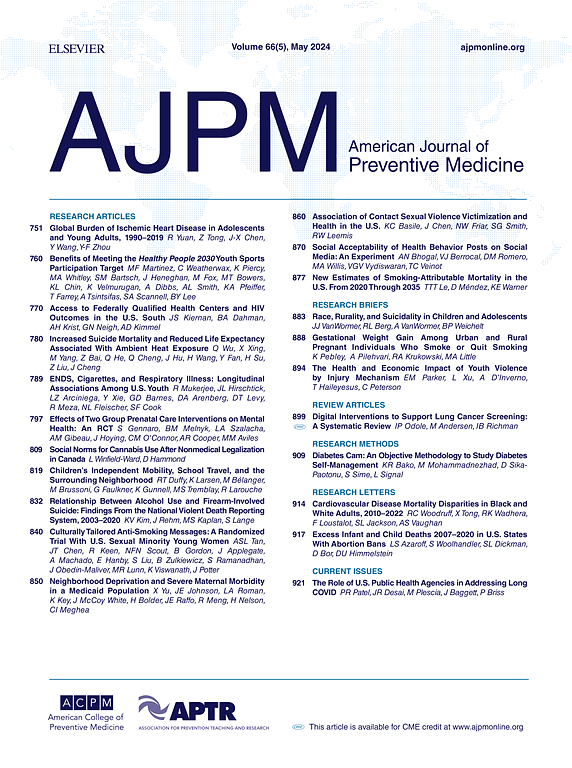Association Between Exercise Program Participation and Hospitalization of Older Adults
IF 4.3
2区 医学
Q1 MEDICINE, GENERAL & INTERNAL
引用次数: 0
Abstract
Introduction
Government and insurance sponsored exercise programs have demonstrated decreased hospitalizations, but it is unclear if this is the case for self-referred programs.
Methods
In this retrospective cohort study from 2013 to 2020, older adults who participated for at least three months at a community-based exercise center (participants) were compared with those who did not (nonparticipants). Each completed a baseline physical assessment and periodic reassessments thereafter. These data were paired with regional hospital data and a national mortality database. Statistical analysis and modeling were performed from 2020 to 2023. Survival to all-cause hospitalization was assessed with a priori subgroup comparison by gender and cox proportional hazard modeling by age, gender, and comorbidities.
Results
The cohort included 718 adults, mean age 69.5 years (SD 8.4), with 411 (57.2%) participants and 307 nonparticipants. Mean follow-up was 26.7 months. Participants had similar baseline measures of fitness (p>0.05) but were more likely to be retired and less likely to have diabetes or prior stroke than nonparticipants. Sustained participation was associated with a reduced rate of all-cause hospitalization (9.0% vs. 12.7%, p=0.02), even when adjusted (HR 0.54; 95% CI 0.34, 0.87, p=0.01). This decrease was noted only in women (p=0.03) but not in men (p=0.49), gender was nonsignificant after adjustment for comorbidities (p=0.15).
Conclusions
Exercise program participation was independently associated with decreased risk of all-cause hospitalization, with possible differential effects by gender. Further randomized trials of the benefits of personalized exercise programs are warranted to assess sex- and gender-specific effects.
老年人参加运动计划与住院之间的关系
导言:政府和保险机构赞助的运动项目已证明住院率有所下降,但自我推荐的项目是否如此尚不清楚:在这项从 2013 年到 2020 年的回顾性队列研究中,参加社区运动中心至少三个月的老年人(参与者)与未参加者(非参与者)进行了比较。每个人都完成了基线身体评估,并在此后定期进行复查。这些数据与地区医院数据和国家死亡率数据库配对。统计分析和建模时间为 2020 年至 2023 年。通过按性别进行先验亚组比较,以及按年龄、性别和合并症进行cox比例危险建模,对全因住院的生存率进行了评估:该队列包括 718 名成年人,平均年龄 69.5 岁(SD 8.4),其中 411 人(57.2%)为参与者,307 人为非参与者。平均随访时间为 26.7 个月。参与者的基线体能测量结果相似(P>0.05),但与非参与者相比,参与者更有可能退休,更不可能患有糖尿病或曾中风。即使经过调整(HR 0.54; 95% CI 0.34, 0.87, p = 0.01),持续参与也能降低全因住院率(9.0% vs 12.7%, p = 0.02)。只有女性(p = 0.03)出现了这种下降,男性则没有(p = 0.49):结论:参加运动计划与全因住院风险的降低有独立关系,不同性别可能有不同影响。有必要对个性化运动项目的益处进行进一步的随机试验,以评估其对性别的影响。
本文章由计算机程序翻译,如有差异,请以英文原文为准。
求助全文
约1分钟内获得全文
求助全文
来源期刊

American Journal of Preventive Medicine
医学-公共卫生、环境卫生与职业卫生
CiteScore
8.60
自引率
1.80%
发文量
395
审稿时长
32 days
期刊介绍:
The American Journal of Preventive Medicine is the official journal of the American College of Preventive Medicine and the Association for Prevention Teaching and Research. It publishes articles in the areas of prevention research, teaching, practice and policy. Original research is published on interventions aimed at the prevention of chronic and acute disease and the promotion of individual and community health.
Of particular emphasis are papers that address the primary and secondary prevention of important clinical, behavioral and public health issues such as injury and violence, infectious disease, women''s health, smoking, sedentary behaviors and physical activity, nutrition, diabetes, obesity, and substance use disorders. Papers also address educational initiatives aimed at improving the ability of health professionals to provide effective clinical prevention and public health services. Papers on health services research pertinent to prevention and public health are also published. The journal also publishes official policy statements from the two co-sponsoring organizations, review articles, media reviews, and editorials. Finally, the journal periodically publishes supplements and special theme issues devoted to areas of current interest to the prevention community.
 求助内容:
求助内容: 应助结果提醒方式:
应助结果提醒方式:


